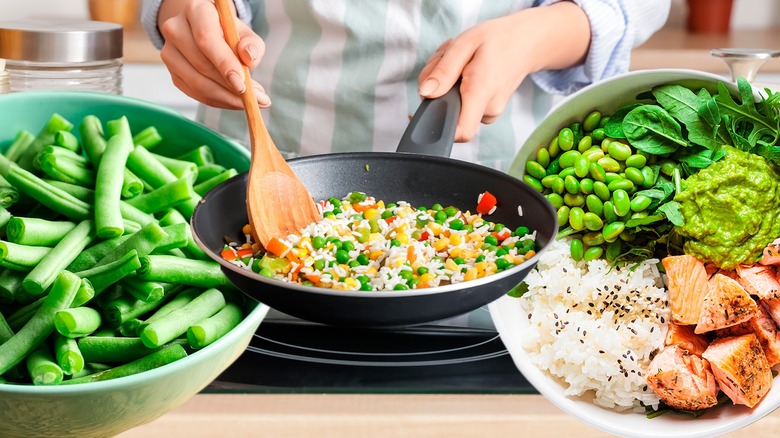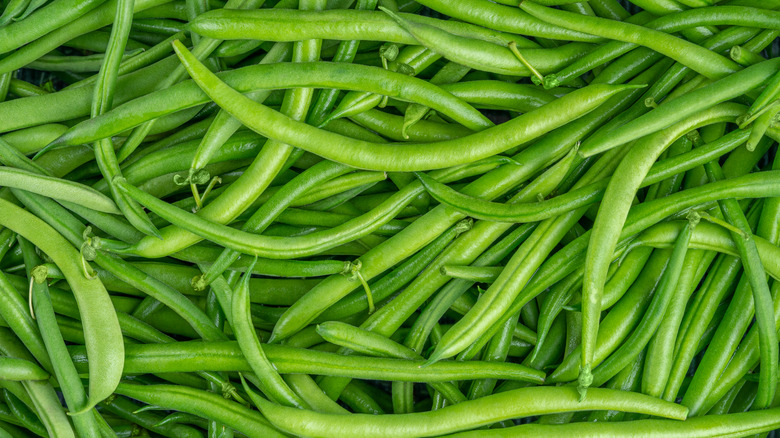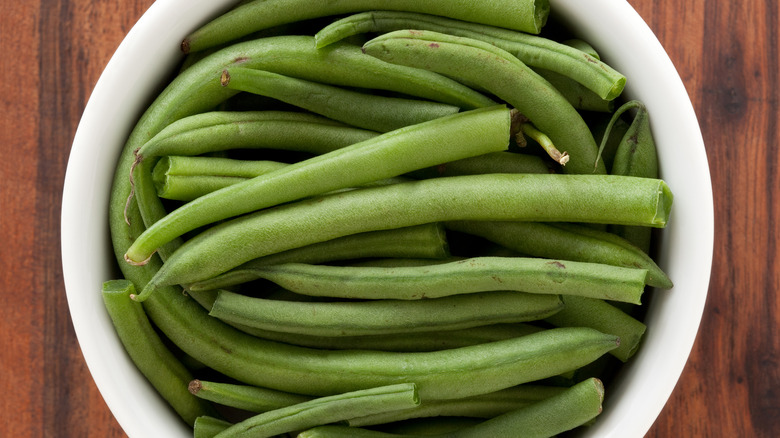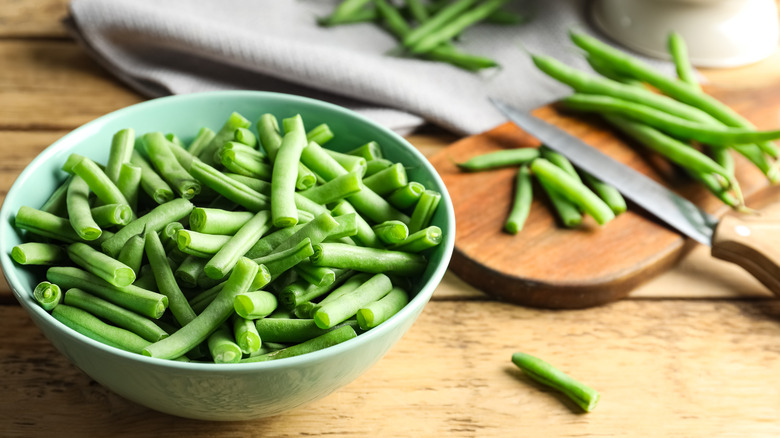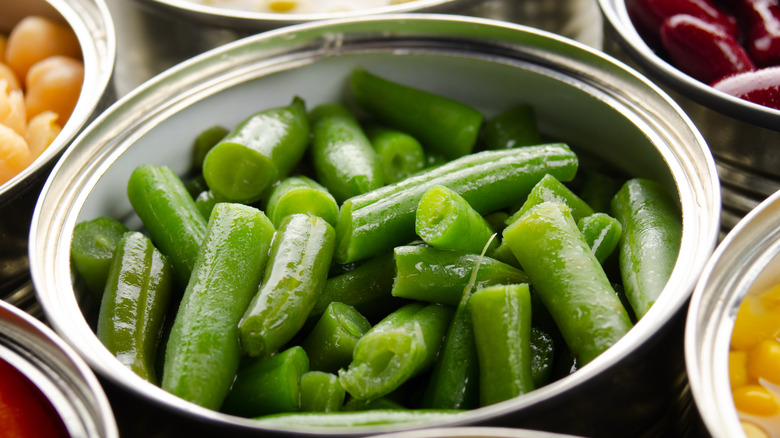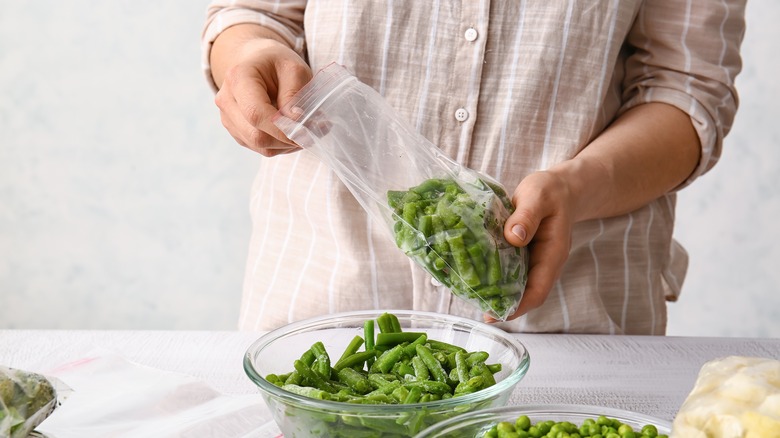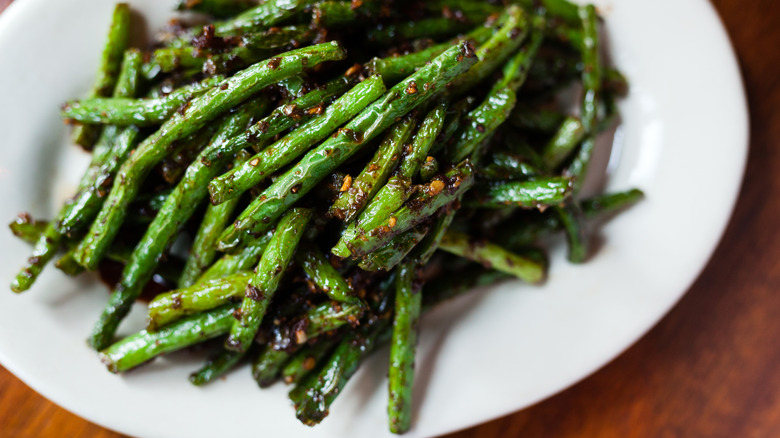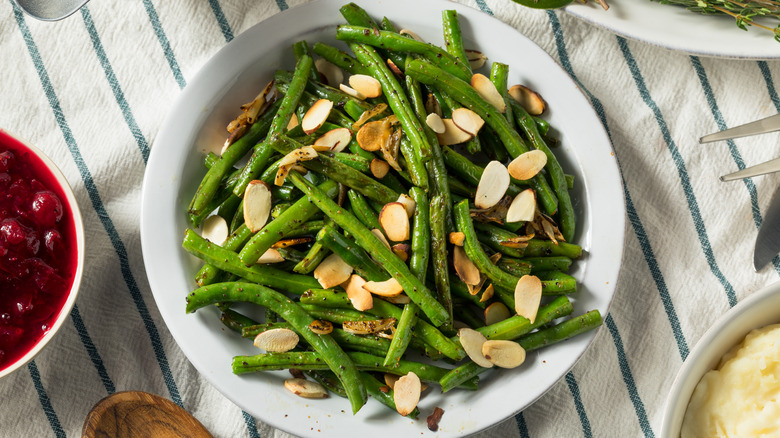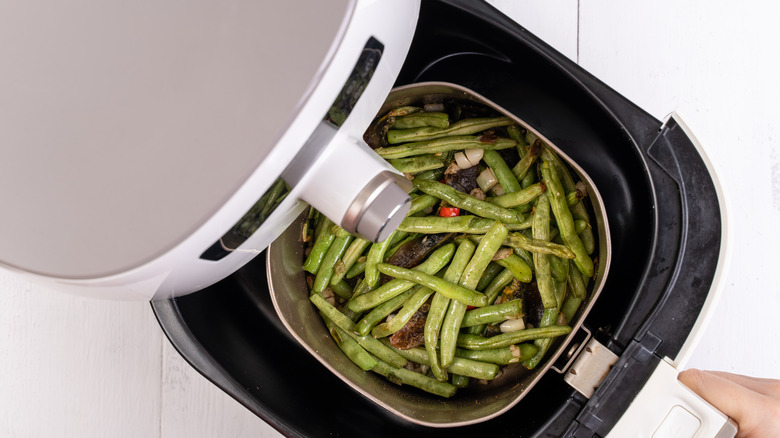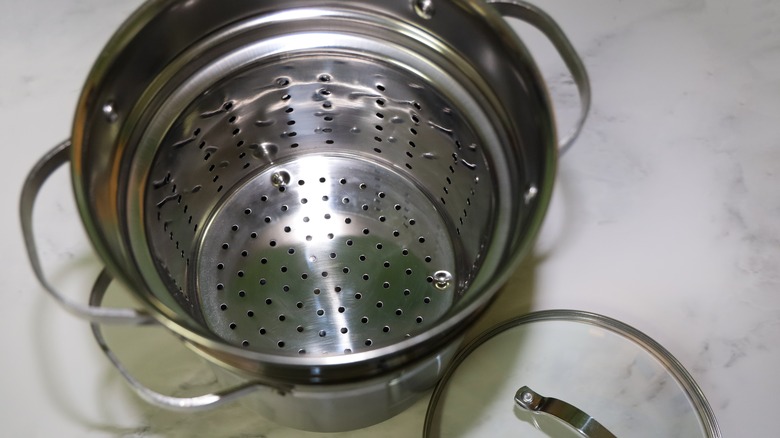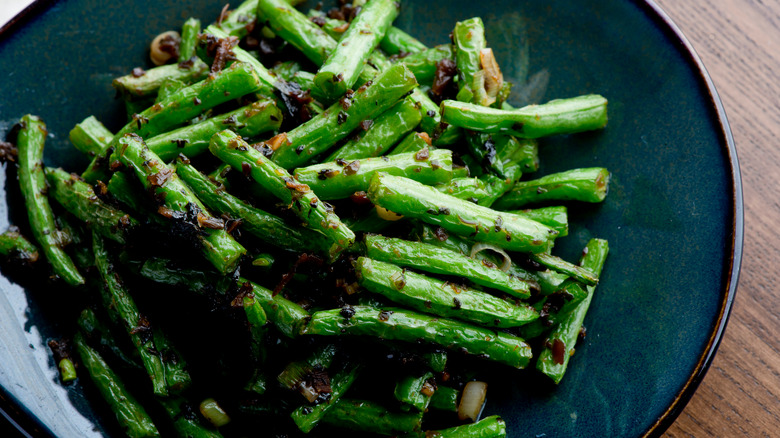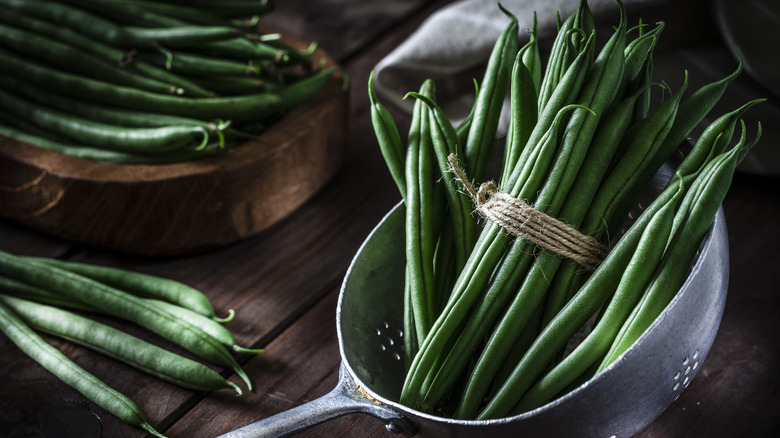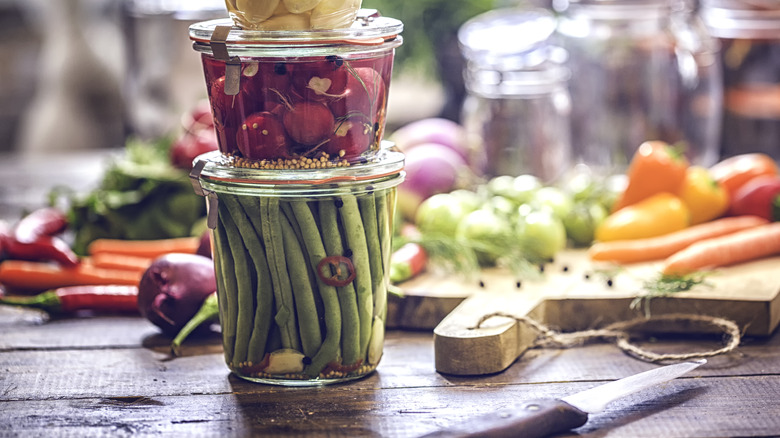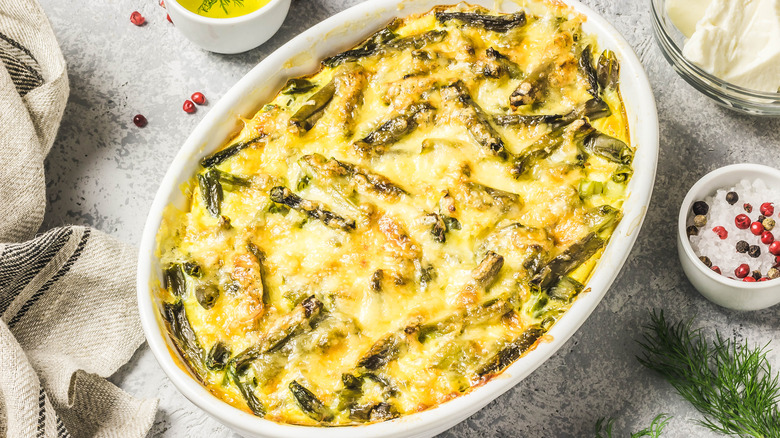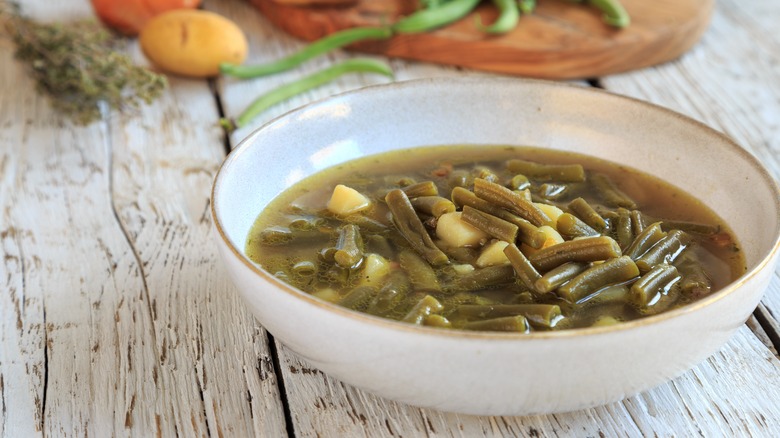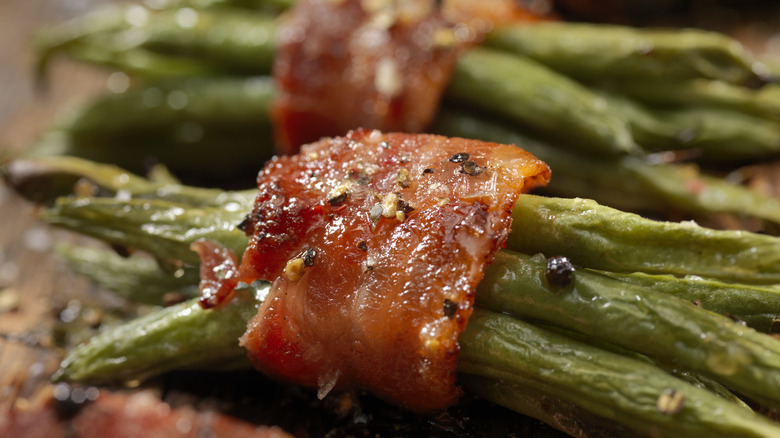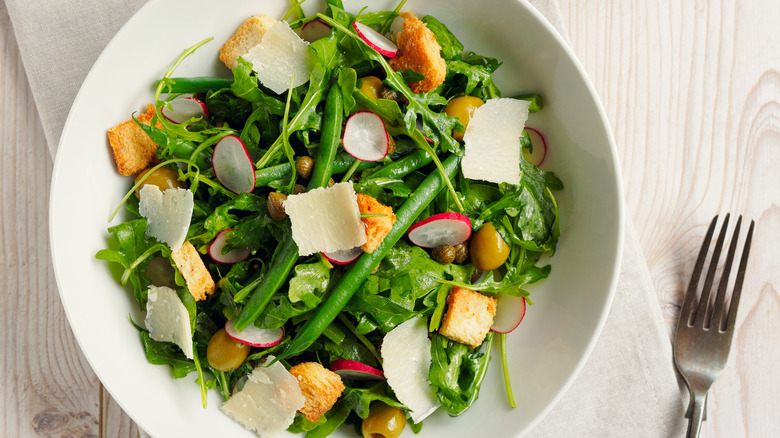17 Cooking Tips You Should Know For Green Beans
Green beans bring a touch of elegance to any meal. This classic vegetable is a staple of menus across the globe. While it's particularly popular in French cuisine, it has a globe-trotting history, originating in South America before spreading to North America and Europe. Over the years, green beans have remained desirable; they're prized for their taste, texture, and versatility. Today, green beans are as well-liked and sought-after as ever, with a market size of over $31 billion in 2019, according to a report from IndexBox (via Global Trade Magazine).
But although these skinny, vibrant beans appear simple and rustic, cooking them correctly is anything but easy. Sure, you can throw them in a pot and boil them until they're pure mush, but if you want to nail your green beans, it takes a fair bit of finesse to get them just right. Luckily, though, you don't have to be a professional chef to perfect your green beans. All you need is a few easy-to-learn, easy-to-execute tips that you can practice in your kitchen, before wowing your friends with your new-found skills. Let's take a look at everything you need to know about cooking green beans.
1. Start with high quality produce
Everything in cooking starts with the quality of your produce. If you purchase a substandard product, you'll end up with a substandard result. But, here's the kicker: You can spend your hard-earned money on the most expensive green beans out there, and still end up with a pack that's somehow poor quality. What gives?
It's all in the freshness, people. As a vegetable, even pricey, gourmet green beans can and will go off pretty quickly. The important thing is not to look at price, but to investigate their quality and freshness so you take home the best beans you can. Ideally, you'll want to select the beans that have the most vivid and uniform green color, with no pale or dark spots on their flesh. When you pick them up, they should have a smooth, friction-free texture, and shouldn't yield or bend when you push on them.
To select the best beans, skip the expensive and pre-packaged products. Instead, head to your local farmer's market. Not only are the green beans in these settings usually sold loose — so you can investigate and feel them yourself — but they're also from local sources, meaning they're fresher.
2. Store them properly
You can buy the freshest produce out there. But unless you stored your legumes correctly once you got them home from the store, then you'll quickly find that no amount of clever cooking can bring them back from the brink.
That's why learning to store your green beans properly is essential. The main thing to remember is to try and keep them dry. While washing green beans when you get home from the store might seem like a logical move, doing so may cause them to deteriorate faster, so only wash them just before you cook them.
To keep them extra dry and protected from deterioration, trying to limit their air contact is also useful. For best results, place the beans in a zip-lock bag, and put a few paper towels inside with them, to soak up any excess moisture. Pop them in the vegetable drawer in your fridge, instead of leaving them at room temperature; the colder they are, the longer they'll last.
3. Trim them correctly
One of the most essential cooking tips for green beans is trimming them. The all-important trimming process allows you to get rid of the stringy, tough edges of the beans — the ones that end up getting stuck in your teeth and left on the side of the plate. If you're not careful, you can end up with a load of misshapen legumes.
But the good news is that trimming green beans in one go can be easy if you are efficient about it. Grab yourself a cutting board, and place your green beans on it in a line or bundle. Then, use the edge of your knife to make sure they're all lined up on one side. Slice all of the tips off at the same point, flip the beans over, and repeat on the other side, ensuring that you don't take too much off.
For this technique, a super-sharp knife is essential — as using one that's too blunt will bruise the beans and cause the edges to become mushy. Once you've trimmed the edges off, you can pop them into a compost bin, or throw them into a pot with some root vegetables to make vegetable stock.
4. Avoid canned green beans
Canned green beans might seem like the height of convenience. Already cooked and prepared, all you need is a tin opener, and the vegetables inside are pretty much good to go. But what you save in time with canned green beans, you lose in quality — and using them in a recipe can be a huge mistake.
As Charleston chef Mike Anderson says, using canned green beans in recipes like casseroles will produce a poor result. "Canned green beans are already soft and will fall completely apart," Anderson states via Mashed. By the time you pull them out of the oven, you'll be left with a green bean mush.
To avoid this, it's always better to go fresh. "Fresh green beans will have a more firm texture, which is what you want in a casserole," advises Anderson. Despite this, Anderson still suggests that green beans benefit from a little cooking before throwing them into a casserole dish with the other ingredients. Lightly steam your beans until they're tender, but not soft, before adding everything else and baking.
5. To freeze them correctly, make sure you blanch
Prepackaged frozen green beans are a freezer must-have for many people. But if you have some leftover green beans from dinner, you can easily freeze them yourself at home, saving you money. Freezing green beans, though, is slightly more involved than you might think. While you certainly can do this, it's a surefire way to make them mushy and tasteless upon defrosting.
To freeze green beans properly, a quick blanch is essential. Doing so keeps them fresh and nutritious, and helps to prevent any enzyme activity that deteriorates the vegetable's flavor over time. All you have to do is pop your green beans in a pot of boiling water and allow them to simmer for a few minutes, stopping short of cooking them until they're soft. Then, remove them and place them in an ice bath for several minutes, to stop them from cooking anymore. Dry them off completely, and then freeze them. You can do this after having removed the tips, or you can leave them on, to remove once you come to use them further down the line.
6. Sautéing them may deliver the best results
Steaming or boiling green beans is an undemanding way to get one of your five a day. But let's be real: steamed or boiled green beans can be boring. While green beans have a pleasant, nutty, somewhat grassy taste, serving them without any adornments can make for a pretty bland side dish.
Next time you come to prepare green beans, we urge you to consider sautéing them. "I strongly prefer sautéing — this preserves the integrity of the bean, keeps them crisp, and takes very little time," says Chicago chef Charlie McKenna, per Insider. As well as this, McKenna points out that sautéing green beans is a space-saver, especially if you're used to roasting your beans. Moving the preparation from the oven to the countertop gives your oven-bound food more room to breathe.
Additionally, sautéing green beans gives you the ability to add any flavor you choose to jazz them up. Always make sure you blanch your green beans before sautéing, so they don't cook unevenly. It takes around 5 to 7 minutes to sauté green beans over medium heat, using approximately one tablespoon of oil for every 3 to 4 servings.
7. Stir through some nuts for extra crunch
Green beans have a serious crunch factor. Like carrots and cucumbers, these legumes contain a satisfying tension that translates (when cooked properly) to being super crunchy. But if this isn't enough for you, then there are ways to amp it up a notch. That's where nuts come in handy.
Tossing a handful of nuts into your green beans recipe is an awesome way to introduce extra crunch and extra nutrition at the same time. Nuts can provide a green bean dish with additional fiber, per Mayo Clinic, which will help to boost green beans' already-impressive fiber content, per Healthline. Nuts may supply a source of healthy monounsaturated or polyunsaturated fats, according to the British Heart Foundation. Nuts also supply an excellent contrasting flavor to the vegetal tones of green beans, giving your side dish a creaminess and richness, without things feeling greasy.
Just remember that adding whole nuts to green bean dishes might overpower the beans themselves, so if you can, use chopped or slivered nut pieces. Sliced almonds, chopped walnuts, and cashew pieces are some of the tastiest and healthiest nuts you can use. Adding a small sprinkle of salt can bring the flavors of both the nuts and the beans out even further.
8. Crisp them up in the air fryer
Air fryers have changed the game. Virtually anything can be made in these handy contraptions, and more often than not, they produce excellent results. That's certainly the case with green beans. Making green beans in an air fryer is an awesome way to create a super-crispy side dish, with the beans cooking through without becoming soft and soggy.
When you combine the beans with other flavors, you can create concoctions that work just as well as a bar snack, as well as next to a slice of quality meat on the dinner table. Try making air fryer parmesan green bean fries next time your friends come over, to seriously impress them. All you have to do is coat trimmed green beans in a combo of panko bread crumbs and grated parmesan — while remembering to dip them into a flour and egg mixture first to help the coating adhere to the vegetable. Then, put them in your air fryer basket, spray them with some cooking oil, and cook for around 6 minutes. Upon removing, the beans will be crispy and flavorful on the outside, but tender on the inside.
9. Add some sourness to contrast their flavor
Green beans can sometimes take a little brightening up. On their own, they can be a little too earthy sometimes, and adorning green beans with a contrasting flavor note can round them out considerably on the palate. A sour element is one of the best things to introduce to green beans, as it supplies a freshness that stops the legumes from becoming too dense and grassy, and plays to their lighter, zingier flavor tones.
A quick spritz of lemon juice or a drizzle of balsamic vinegar will do wonders for green beans, but for best results, try introducing sourness from multiple sources. Combining lemon juice with mustard is one of the best ways to do this, which when combined with grilled green beans makes a side dish worth talking about. Mix lemon juice and mustard (you can also use mustard powder) with some other seasonings, and drizzle over lightly charred green beans, fresh off the grill. The warmth of the beans will help them absorb the flavors even more, and the browning on their surface will supply even more flavor. This is a match made in heaven, folks.
10. Steaming your beans will make them delicious
Boiling green beans is a one-way ticket to soggy town, folks. While it may be the easiest and quickest way to prepare beans, it's also the one that bears the most risk. Leaving your beans in boiling water just a minute too long will remove all their crispy goodness, and leave you with floppy, chewy vegetables.
For the best results, steam them instead. Steaming doesn't just cook the beans gently, ensuring that they retain their snap and crunch while becoming tender. It also helps them to stay nutritious. "While boiling involves submerging the vegetables completely underwater, therefore causing some nutrients — like vitamin C and B vitamins, as well as antioxidants — to leach out into the water, steaming helps retain more of these nutrients," explains Michelle Dudash, a registered dietitian nutritionist, to Runner's World. You won't be pouring those all-important vitamins away anymore with this method.
Steaming green beans requires little more than a steamer basket, some water, and a few minutes of your time. Put the trimmed beans in your basket, and place them over a pot of boiling water. Cover with a lid, and leave them to steam for approximately 3 to 5 minutes, depending on the thickness of your beans and how cooked you want them. To test them, pull one out (being careful not to burn your hands), and bite through it. If it has a gentle snap with a tender inside, it's done.
11. Including spice will deepen their flavor
We don't know about you, but we're constantly on the lookout for new ways to spice food up. If you're running out of inspiration, we hereby present some, via the medium of green beans. Green beans are an excellent vehicle for spicy flavors, and supply a fragrance and heat to them, giving a whole new side to the dish you're making.
Virtually any spice will go with green beans, thanks to their relatively neutral flavor. Slightly earthier spices like cumin pair particularly well with them. If you want full-on heat, cayenne pepper, chili flakes, or fresh chilies all supply intensity. If you fancy Indian cuisine, combine multiple spices in a masala green beans dish. Coriander, cumin, and chili powder all combine to create a balanced curry flavor. Turmeric adds savoriness, while also tinging everything with a golden hue. Adding fenugreek, curry powder, or garam masala will further elevate the dish.
12. Avoid using beans that are past their best
Green beans, like other vegetables, can be fickle. One minute, they're perfectly fresh, glowing with a vibrant green color and firm to the touch, and the next, they're ready to be thrown out. Figuring out when green beans are no longer in their prime — and how long they generally last — will save you a lot of embarrassment when serving dinner.
Generally, uncooked green beans will stay fresh for 5 to 7 days in the refrigerator, provided that they're stored correctly and kept dry. Damp beans are likely to go bad quickly and develop mold, creating food risks. After around a week, they'll usually need to be thrown out, as following that they'll start to turn bad.
Limpness is one of the first things to look out for in green beans. Once they lose their firmness, they'll be less pleasant to eat. You can check this easily by taking one of your green beans and bending it slightly. If it's still fresh, the bean won't yield very much and will snap instead. A green bean that's past its prime, though, will have a rubbery texture, bending easily.
13. Pickling preserves and improves them
While pickled cucumbers, pickled cabbage, and pickled onions are pretty popular, pickled green beans are less so. But these thin vegetables are seriously good for pickling, and they have the added advantage of being the perfect shape to pack into a jar and fish out hungrily once they're done. Pickling green beans gives them a sharpness and punch without compromising their firm and crunchy consistency. Whether served as part of a meal, or on their own with an ice-cold drink, it's the snack you didn't know you needed.
Pickled green beans are far easier to make than you might think. Just add a pickling solution — made from vinegar, water, and canning salt — into jars full of green beans. Make sure the jars are sterilized first, and leave a little space at the top of the jar. Add in any seasonings you desire to flavor the beans, and then seal the jars, fully submerge them in water, and boil them for roughly ten minutes. Take them out, leave them to cool fully, and allow the pickling to do its magic for a few weeks, before opening and enjoying those deep, briny flavors.
14. Adding contrasting textures will elevate your dish
Much is made of green beans' crunchy texture. But while this is certainly satisfying, it's entirely possible to have too much of a good thing. One of our top tips for cooking green beans is to learn how to work contrasting textures.
Introducing a creamier element to green beans, either through a casserole-style dish or simply by stirring milk products through to make creamy green beans, is an excellent way to avoid them becoming one-note. Creamy textures soften the beans somewhat and provide not just a textural counterpoint, but a new flavor element too. If you want to keep things simple, fry up some onions and garlic, and then add your green beans, stirring to coat everything before drizzling over some cream, or spooning in some sour cream. Toss everything together, season, and serve.
If you don't have time for that, though, we've got another top tip for you: Simply add a generous pat of butter to your green beans. The creamy fats in the butter will work wonders with the legumes.
15. To avoid soggy beans, add them later in the cooking process
One of the biggest problems that people face when cooking beans is the mush factor. Exposing them to heat for too long will soften them beyond repair, and as green beans tend to take on water the longer they cook, you can quickly end up with a waterlogged portion of veggies.
This can be a particular problem when you're adding green beans to add crunch to a soup or stew, only to find that they've somewhat dissolved upon the meal reaching the dinner table. Therefore, they should always be added towards the end of a dish's cooking time if possible. Green beans only take 3 to 5 minutes to boil, so by putting them in a liquid-based meal at the last minute, you'll ensure they stay crunchy.
If you want to fine-tune the texture of your beans, you can also always cook them before you add them to food. Bear in mind, though, that by doing this, the beans won't take on much of the flavor in your soup or stew, and will merely be coated with the cooking liquid.
16. Add some meat for a full meal
Green beans have a slight bulk to them which makes them somewhat satisfying. But there's no denying that as veggies go, they're on the more delicate side of things. No one's under any illusions that, on their own, they don't exactly make the most filling meal.
But when combined with a heartier element like bacon, things can start to look a lot more satisfying, with the protein and fat in the meat making things a lot more satiating. Try cooking some skillet green beans with mushrooms and bacon, by sautéing mushrooms with garlic and spices, adding them to blanched green beans, and topping with crispy bacon.
Aside from the appetite-satisfying benefits that bacon has, it also delivers serious flavor, with the fat and salt coming together to boost the umami factor of the beans. Other cuts of pork, like pancetta or pork belly, also go well with beans. For people who don't eat meat, using smoked tofu or seitan can provide a similar depth of flavor while bulking the beans out. Green beans also go excellently with tofu and other meat substitutes as part of a stir-fry.
17. Use them in a salad
If you only serve your green beans hot, you're missing out. Green beans are the perfect addition to a salad, where their firmness and crunch truly come into their own. If you want to soften them a little, blanching the beans first will make them more tender and easy to chew through. But it's also useful to remember that green beans can be served raw, so if you can't face the effort of cooking the beans first, just slice them up and throw them in.
The versatility of green beans means that they can go in pretty much any salad you're making. They're as at home with a French-style vinaigrette as they are with a creamier dressing. If you want to go a little more left-field, though, try a hoisin green bean salad. Add cooked green beans to a bowl, and then combine hoisin sauce, sesame oil, apple cider vinegar, and agave, pouring the mixture over the vegetables. The sharpness of the vinegar and sweetness of the hoisin pair well with the firm, more earthy-tasting beans. Mix it all together, and then pour it onto a serving plate, topping the whole thing with sesame seeds before serving.
Static Media owns and operates Daily Meal and Mashed.
